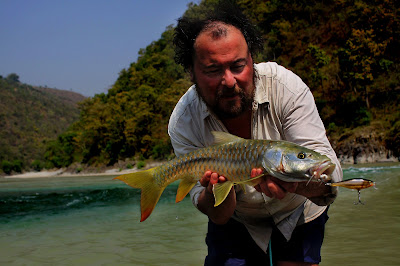Wednesday, May 5, 2010
What the FISH!
Pic: Gaurav Kataria
Golden Mahseer, the world’s strongest freshwater game fish, gasps for breath
One blustery afternoon, somewhere up in the Himalayan foothills, a wiry young man, stripped down to the waist, casually holds a stick of dynamite with a lit fuse. Shielding it from the strong gust, he waits for the hissing wire to burn down to the cap before lobbing it into the river before him.
Boom! The man synchronises his dive with the bang and lunges headfirst into water. A few moments later, he resurfaces, jubilant, with a bunch of dead fish in his hands. Welcome to the world of dynamite fishing.
If you can’t bait them, blow them up, the local populace says. Or better still; electrify them with naked telephone wires hooked to high-voltage overhead tran smission lines. Sadly, this is how one of the world’s finest sport fishing locales is being wasted.
Sample this: According to the American Sportfishing Association, around 44 million people in the US go fishing every year. It generates $45 billion in retail sales with a further $125 billion impact on the nation’s economy. Tata Motors’ consolidated revenues in 2008-09 were $14 billion.
While the rest of India is crying itself hoarse over big cat conservation, the country is swiftly losing some of its most attractive game fish and angling habitats, thanks to dams, rising population and ignorance.
Thousands of anglers from all over the world visit India every year to experience sport fishing. The Prince of Wales (later Edward VIII) was one of them. Anglers come in search of the Golden Mahseer, which inhabits the rivers and perennial rivulets of sub-mountainous terrain in the Himalayas and can be found up to an altitude of 2,500 ft. But last month, when adventurer Gaurav Kataria led a team of British anglers to the Maha Kali River, stronghold of the Golden Mahseer, this is what he saw.
“Most of the deep pools in the river were empty. Villagers were using explosives to blast fish out of water,” says Kataria. The Golden Mahseer is the strongest freshwater fish in the world growing up to nine feet and weighing up to 60 kilo. But as with other forms of wildlife, it is no match for humans wielding dynamite sticks.
Illegal fishing of rare species take place around almost all Himalayan rivers with tinges of human settlement on their banks, and the Maha Kali River is no exception. The Ramganga River, which slices Corbett National Park in Uttarakhand into half, is a Mahseer paradise. Dynamite fishing by locals used to be rampant till a couple of UK-based angling enthusiasts decided to take things into their own hands.
Chris Summers, who works for Wychwood-Game, a British sport fishing equipment manufacturer, decided to set up base in Bhikyasen, a sleepy hamlet near Corbett National Park. Along with girlfriend Ellie Gibbons, a professional photographer, he has been working with the locals to conserve the Mahseer habitats. “You have to work with the local community. You have to make them understand that sport fishing can prove to be lucrative for them too,” he says.
Local boys now work to retrieve lures that cost $30 each from the river. Anglers would otherwise have abandoned them. “10 lures a day is good money for these boys,” Summers says. Supplies for the camp are also bought from local stores. It’s a win-win situation, for the river as well as the villagers.
Taking a cue from Summer’s book, Mark Everard, author and environmental scientist, is working on various models to reverse the harm done to Himalayan rivers by illegal fishing and damming. “We have to start small and repeat the pro cess along the river,” Everard says. “I am in talks with various environmental bodies in the UK on how we can help conserve the eco system of these rivers.” Everard, who was on an angling trip here, isn’t the only one madly in love with the Golden Mahseer.
Said Rudyard Kipling: “There he stood, the Mahseer off the Poonch, beside whom the Tarpon is a Herring and he who catches him can say he is a fisherman.” The Tarpon weighs 100 kilo and is considered to be one of the greatest of all saltwater game fish.
That says it all about our mighty Mahseer.
Saturday, May 1, 2010
The Lost Wolves Of India
Pic: Dharmendra Khandal
Sidelined by the glamour of tiger conservation, the ancestor of man's best friend is fighting a losing battle
Rome wasn’t built in a day. And maybe, a wolf had something to do with it. Legend has it that Rome’s twin founders, Romulus and Remus, were thrown into the Tiber river by their uncle Amulius and left to die. But a she-wolf thought otherwise and rescued them. The bronze sculpture of the wolf, Capitoline Wolf, has been housed in one of the Capitoline Museums in Rome since 1473 and is a hot tourist attraction. But closer home, the ancestor of man’s best friend is in deep trouble.
The Indian wolf is a highly endangered animal. Only 2,000 are estimated to be alive, according to studies. And the number is dwindling. Says Asad Rehmani, director, Bombay Natural History Society: “The Indian wolf is perhaps more endangered than the tiger as no attention given to its habitat, which is dry thorn forest, low-intensity agricultural land with broken hills, undulating grassland and scrubland with good natural prey base. It is a neglected species and dying slowly as the glamour and politics of tiger conservation takes over the conservation movement of India”. Wolves are shot, poisoned and their young ones smoked out and killed.
This is considered to be unfortunate by wildlife conservationists since the Indian wolf is the apex predator of the Indian desert and grasslands, in other words, unprotected areas. It is to these areas what the tiger is to the forest. It is found mainly in Bihar, UP, MP, Rajasthan, Maharashtra, AP, Karnataka and Gujarat. Its main role is to keep the population of ungulates (hoofed animals) down to reasonable numbers.
Studies conducted by Y Jhala of the Wildlife Institute of India, Dehradun, have proved that the wolf of the world originated from the Indian wolf. Conservationists believe this is reason enough to save the species. Ironically, the Indian wolf is protected under the Wildlife Protection Act of 1972.
Cornered by habitat depletion, wolves are being killed as a vermin and menace. And this sad story began in 1878 when 624 people were reportedly killed by wolves in UP. During the same period in Bengal, 14 others were killed. Slowly, the wolf earned the notorious nickname “child-lifter”. In 1995, wolves attacked 80 children in Bihar, of which 20 were rescued.
“The biggest problem is that there is no scheme to compensate shepherds and farmers when their livestock is killed by a wolf, as we see in tiger areas,” says Jhala.
The solution lies in development of a compensation scheme for any damage caused by the wolf, protection of grasslands, long-term study on wolf ecology and biology through radio-tracking, genetic studies, protection of dry deciduous forests of Kutch and some districts of Saurashtra in Gujarat, protection of grasslands beeds in Saurashtra and rakhals in Kutch (grasslands are called bheeds or beeds in Saurashtra, western Madhya Pradesh and eastern Rajasthan, and rakhals in Kutch). Says Dharmendra Khandal, a conservation biologist based out of Ranthambore: “These can serve as denning areas for the wolf and they can breed there in peace.
Khandal has been tracking wolves for quite some time now. “Money is not enough to be able to see a wolf in the wild. You need the endurance to rough it out in the wild as they are not found easily in national parks,” he says.
Well, that is what real wildlife is all about, isn't it? Just don't carry silver bullets.
Bitter Truth About Tiger Conservation
Pic: Dharmendra Khandal
Ranthambore's tigers are still fighting, hold your breath, forest officials
On enormous billboards, in cities and on highways, a strategically planned campaign recently announced that there are only 1,411 tigers left in the country. The cute cubs shared space with prominently displayed id entities of the corporate sponsor, while on national TV celebrities mouthed their sensitive side by endorsing the campaign.
Yet, within the premises of protected national parks, under the gaze of the authorities, two cubs and three adult tigers lost their lives after the campaign hit the headlines.
Here is something more shocking: after the tiger census of 2007, which threw up the 1,411 headcount, India reportedly lost 32 tigers in 2008 and another 86 in 2009. And in the first 50 days of 2010, the country lost 62 leopards, the smallest of the “big cats”.
Officials seem concerned, but largely clueless. But one man, Dharmendra Khandal, conservation biologist at Tiger Watch in Ranthambhore, India’s best-known tiger sanctuary, has been fighting an almost lonely battle, even putting his life on the line. Not only does he face hostility from poachers but also an inexplicable disapproval of the authorities.
During a 2003-04 killing spree, a semi-nomadic tribe called Moghiyas, some of them excellent bushmen and trackers, reduced Ran tham bhore’s tiger population by half. They were a notorious part of the illegal international wildlife trade that generates some $20 billion a year. Khandal went after them and in what tur ned out to be one of the most successful anti-poaching operations in the world, he got most of them arrested.
Around the same time, the news came out that Rajasthan’s other tiger reserve, Sariska, had lost all its big cats to poachers!
Interestingly, till this setback, Project Tiger -- 27 reserves established in 1973 -- was making headlines as one of the world’s biggest conservation stories. While other countries were losing their tigers, India’s tiger population grew from 1,200 to 3,600. But after the startling revelation of the 2007 census, the government had no option but to pump in $125 million to increase the number of reserves by 12 and beef up security at Sariska and Ranthambhore. Ranthambhore now has around 40 tigers. Recently, a couple of tigers were also introduced to Sariska.
But Khandal is not convinced. “They are siblings. It’s impossible for them to produce healthy offspring due to inbreeding,” he says.
Though poachers and their highly efficient peripheral network around national parks are a continuing threat to wildlife, conservation experts feel that there are other immediate issues that the government needs to look into.
For instance, guard towers are being constructed in the core area of Ranthambhore National Park. Says Khandal, “There is no point in having towers in the core area. Unnatural presence disturbs the breeding pattern of tigers and pushes them out of their natural habitats. The towers should be put up around the perimeter of the forest from where the miscreants make an entry. Monitoring should be done in constantly moving vehicles.”
In another significant development, the ministry of environment and forests is planning to spend Rs 8,000 crore to relocate nearly 80,000 families from in and around forest areas. In Ranthambhore’s case, Rs 100 crore is being spent to relocate nearly 1,200 families. Each family is being paid Rs 10 lakh to leave. But the problem lies in the way the operation is being carried out. “There are families that own land in these villages. So, even if some of them leave, others would want to carry on farming in the space left vacant. In fact, some of them have already started doing so,” discloses a forest official who does not wish to be identified.
Livestock grazing, illegal cutting and collection of firewood and mining in the buffer areas of Ranthambhore are some of the other major concerns. Adding to the callous man-made dangers to the tiger population, a weed named prosopsis juliflora is wreaking havoc in Sawai Madhopur’s tiger territory. The battle to save the tiger is far from over.
Subscribe to:
Posts (Atom)






